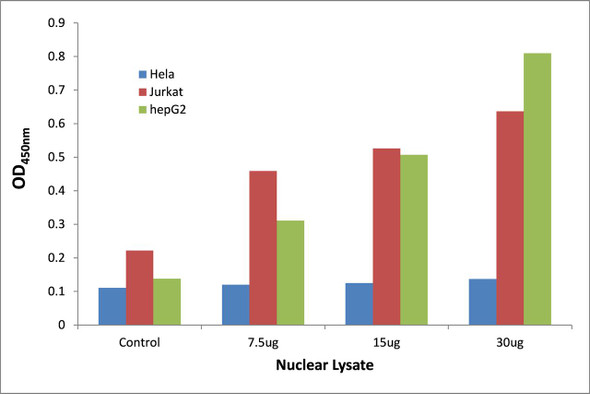Description
| Product Name: | STAT5B Transcription Factor Activity Assay |
| Product Code: | TFAB00186 |
| Target: | STAT5B |
| Reactivity: | Human, Mouse, Rat |
| Sample Types: | Nuclear or cell lysates |
The Assay Genie STAT5B transcription factor activity assay allows for the detection and qualitative analysis of endogenous levels of activated transcription factors in a variety of nuclear and cell lysates
Assay Genie ELISA kits are designed to significantly reduce experiment time and ensure sensitivity and flexibility for high-throughput screening.
| Assay Time: | 4.5 hours |
| Detection Method: | Colorimetric 450 nm |
| Size: | 12 x 8-Well Microstrips |
| Storage: | 4°C for 6 months |
| UniProt Protein Function: | STAT5B: transcription factor of the STAT family. Phosphorylated and activated by receptor-associated kinases triggered by cytokines including IL2, IL3, GM-CSF, and various growth hormones. It has been shown to be involved in diverse biological processes, such as TCR signaling, apoptosis, adult mammary gland development, and sexual dimorphism of liver gene expression. Forms homo- or heterodimers that translocate into the nucleus where they regulate transcription. |
| UniProt Protein Details: | Protein type:Oncoprotein; Transcription factor; DNA-binding Chromosomal Location of Human Ortholog: 17q11.2 Cellular Component: cytoplasm; cytosol; nucleoplasm; nucleus Molecular Function:chromatin binding; glucocorticoid receptor binding; protein binding; protein dimerization activity; protein phosphatase binding; signal transducer activity; transcription factor activity Biological Process: 2-oxoglutarate metabolic process; acute-phase response; allantoin metabolic process; cellular response to hormone stimulus; citrate metabolic process; creatine metabolic process; creatinine metabolic process; development of secondary female sexual characteristics; development of secondary male sexual characteristics; fatty acid metabolic process; female pregnancy; isoleucine metabolic process; JAK-STAT cascade; lactation; liver development; luteinization; natural killer cell differentiation; negative regulation of apoptosis; negative regulation of erythrocyte differentiation; oxaloacetate metabolic process; Peyer's patch development; positive regulation of activated T cell proliferation; positive regulation of B cell differentiation; positive regulation of cell motility; positive regulation of gamma-delta T cell differentiation; positive regulation of inflammatory response; positive regulation of interleukin-2 biosynthetic process; positive regulation of mitotic cell cycle; positive regulation of multicellular organism growth; positive regulation of natural killer cell differentiation; positive regulation of natural killer cell mediated cytotoxicity; positive regulation of natural killer cell proliferation; positive regulation of smooth muscle cell proliferation; positive regulation of transcription from RNA polymerase II promoter; progesterone metabolic process; regulation of epithelial cell differentiation; regulation of multicellular organism growth; regulation of steroid metabolic process; regulation of transcription from RNA polymerase II promoter; response to estradiol stimulus; response to ethanol; response to hypoxia; response to lipopolysaccharide; sequestering of lipid; succinate metabolic process; T cell differentiation in the thymus; T cell homeostasis; taurine metabolic process; transcription from RNA polymerase II promoter; valine metabolic process Disease: Growth Hormone Insensitivity With Immunodeficiency |
| NCBI Summary: | The protein encoded by this gene is a member of the STAT family of transcription factors. In response to cytokines and growth factors, STAT family members are phosphorylated by the receptor associated kinases, and then form homo- or heterodimers that translocate to the cell nucleus where they act as transcription activators. This protein mediates the signal transduction triggered by various cell ligands, such as IL2, IL4, CSF1, and different growth hormones. It has been shown to be involved in diverse biological processes, such as TCR signaling, apoptosis, adult mammary gland development, and sexual dimorphism of liver gene expression. This gene was found to fuse to retinoic acid receptor-alpha (RARA) gene in a small subset of acute promyelocytic leukemias (APLL). The dysregulation of the signaling pathways mediated by this protein may be the cause of the APLL. [provided by RefSeq, Jul 2008] |
| UniProt Code: | P51692 |
| NCBI GenInfo Identifier: | 41019536 |
| NCBI Gene ID: | 6777 |
| NCBI Accession: | P51692.2 |
| UniProt Secondary Accession: | P51692,Q8WWS8, |
| UniProt Related Accession: | P51692 |
| Molecular Weight: | 89,866 Da |
| NCBI Full Name: | Signal transducer and activator of transcription 5B |
| NCBI Synonym Full Names: | signal transducer and activator of transcription 5B |
| NCBI Official Symbol: | STAT5B |
| NCBI Official Synonym Symbols: | STAT5 |
| NCBI Protein Information: | signal transducer and activator of transcription 5B |
| UniProt Protein Name: | Signal transducer and activator of transcription 5B |
| UniProt Gene Name: | STAT5B |
| UniProt Entry Name: | STA5B_HUMAN |






